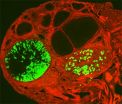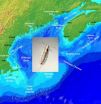(Press-News.org) Scientists at the National Physical Laboratory (NPL) have produced a synthetic air reference standard which can be used to accurately measure levels of carbon dioxide and methane in the atmosphere. This will greatly help scientists contribute to our understanding of climate change.
A paper published in Analytical Chemistry describes how researchers at NPL have created a synthetic gas standard for the first time, which is comparable to the World Meteorological Organisation (WMO) scale and can be quickly produced in a laboratory and distributed, meeting growing demand.
The bulk of demand for gas standards comes from atmospheric monitoring stations around the world. The data collected from these is important to our understanding of climate change.
To reliably compare the concentration of carbon dioxide and methane in air at different locations, and over time, a primary standard to which all measurements relate is required. We must be able to relate the measurements to a trusted base unit, so we can reliably compare measurement between London and Beijing, or between 1990 and 2014.
The current primary standards for carbon dioxide and methane are a suite of cylinders of compressed air captured from Niwot Ridge in Colorado and held at the National Oceanic and Atmospheric Administration (NOAA).
They are used to create secondary standards, which are used to calibrate the instruments that measure greenhouse gasses around the world.
A new improved measurement technique - cavity ring-down spectroscopy (CRDS) - has resulted in a dramatic increase in the number of atmospheric measurements taken. As the requirement for data that is comparable to the WMO scale increases, there is a corresponding increase in the demand for comparable reference standards.
Supplying the demand for reference standards comparable to the WMO scale is becoming an issue. An infrastructure to disseminate reference standards prepared gravimetrically – i.e. by weighing the gas in the cylinder - that are traceable to the International System of Units (SI) offers a means of broadening availability. These could overcome the cost and complexity of sampling air under global background conditions which can only be carried out at remote locations.
NPL has developed a solution, producing a synthetic standard which can be used to calibrate carbon dioxide and methane measuring instruments. Rather than sampling air directly, NPL created the sample in the laboratory by carefully blending a mix of gaseous components found in air.
However preparing reference standards synthetically presents a significant challenge. Industrially produced carbon dioxide has a different isotopic distribution to that of atmospheric air, which measurement instruments read differently.
Paul Brewer, Principal Research Scientist at NPL, said: "By using high accuracy gravimetry, we were able to prepare a gas mixture that accurately replicated the natural occurring isotopic carbon dioxide. The samples were tested using NPL's world leading measurement equipment and expertise, which demonstrated that the synthetic standard was comparable with the NOAA standard and suitable for use with the international measurement scale for atmospheric monitoring."
The research has demonstrated that air standards comparable to the WMO scale can be prepared synthetically with an isotopic distribution matching that in the atmosphere. The methods used can be replicated, leading to widespread availability of standards for globally monitoring these two high impact greenhouse gasses. For the international atmospheric monitoring community and for gas companies, this could solve the pressing supply issue.
The project has received widespread support from the atmospheric measurement community. Euan G. Nisbet, Foundation Professor of Earth Sciences at Royal Holloway maintains an Atlantic network of greenhouse gas measurements. He says: "Standards are a critical problem in greenhouse gas measurement. Developing high accuracy reference standards of carbon dioxide and methane with international comparability, and traceability to the SI, will greatly contribute to our work, and to improving our understanding of how greenhouse gases affect the atmosphere."
INFORMATION:
The full paper can be viewed here: http://pubs.acs.org/doi/abs/10.1021/ac403982m
NPL scientists blend synthetic air to measure climate change
New gas standard to meet increasing demand
2014-02-26
ELSE PRESS RELEASES FROM THIS DATE:
Self-administration of flu vaccine with a patch may be feasible, study suggests
2014-02-26
The annual ritual of visiting a doctor's office or health clinic to receive a flu shot may soon be outdated, thanks to the findings of a new study published in the journal Vaccine.
The research, which involved nearly 100 people recruited in the metropolitan Atlanta area, found that test subjects could successfully apply a prototype vaccine patch to themselves. That suggests the self-administration of vaccines with microneedle patches may one day be feasible, potentially reducing administration costs and relieving an annual burden on health care professionals.
The ...
New blood analysis predicts risk of death
2014-02-26
The general state of a person's metabolism can be diversely illustrated with a new scientific blood analysis. With the aid of the analysis biomarkers predicting short-term mortality have now been discovered.
If a person belongs to a risk group based on these biomarker concentrations, he/she has a multifold risk of dying in the next five years compared to the general population. The study is based on blood samples of over 17,000 Finnish and Estonian people.
Mortality was related to four biomarkers in the blood: levels of two proteins (albumin and alpha-1 acidic glycoprotein), ...
Self-rated physical fitness in midlife an indicator of dementia risk
2014-02-26
How would you rate your own physical fitness? Is it good, satisfactory or maybe even poor? Surprisingly, your answer may reveal your future risk of getting dementia.
A recent collaborative study from Finland, involving the follow-up of 3,559 adults for 30 years, has found that a simple question about self-rated physical fitness in midlife may reveal individuals who are at an increased risk of developing dementia. Those who reported poor self-rated physical fitness in midlife, at the mean age of 50 years, were four times more likely to get dementia during the next three ...
Different eggs in adolescent girls and adult women
2014-02-26
Are the eggs produced by adolescent girls the same as the ones produced by adult women? A recent study published in Human Molecular Genetics by Professor Kui Liu from the University of Gothenburg in Sweden shows compelling evidence that there are two completely distinct types of eggs in the mammalian ovary – "the first wave" and "the adult wave".
Professor Liu's team used two genetically modified mouse models to show that the first wave of eggs, which starts immediately after birth, contributes to the onset of puberty and provides fertilizable eggs into the transition ...
Hormone therapy linked to better survival after lung cancer diagnosis in women
2014-02-26
DENVER – Survival among people with lung cancer has been better for women than men, and the findings of a recent study indicate that female hormones may be a factor in this difference. The combination of estrogen plus progesterone and the use of long-term hormone therapy were associated with the most significant improvements in survival.
The study was designed to explore the influence of several reproductive and hormonal factors on overall survival of women with non-small cell lung cancer (NSCLC). After adjusting for stage of disease at diagnosis, treatment type (surgery ...
Don't throw out old, sprouting garlic -- it has heart-healthy antioxidants
2014-02-26
"Sprouted" garlic — old garlic bulbs with bright green shoots emerging from the cloves — is considered to be past its prime and usually ends up in the garbage can. But scientists are reporting in ACS' Journal of Agricultural and Food Chemistry that this type of garlic has even more heart-healthy antioxidant activity than its fresher counterparts.
Jong-Sang Kim and colleagues note that people have used garlic for medicinal purposes for thousands of years. Today, people still celebrate its healthful benefits. Eating garlic or taking garlic supplements is touted as a natural ...
Better remote-sensing explosive detectors: The beginning of the end of full-body scanners?
2014-02-26
Standing in a full-body scanner at an airport isn't fun, and the process adds time and stress to a journey. It also raises privacy concerns. Researchers now report in ACS' The Journal of Physical Chemistry Letters a more precise and direct method for using that "terahertz" (THz) technology to detect explosives from greater distances. The advance could ultimately lead to detectors that survey a wider area of an airport without the need for full-body scanners.
R. Kosloff and colleagues explain that using THz spectroscopy by itself is challenging for sensing far-away explosives. ...
Caffeine-based gold compounds are potential tools in the fight against cancer
2014-02-26
The side effects of ingesting too much caffeine — restlessness, increased heart rate, having trouble sleeping — are well known, but recent research has shown that the stimulant also has a good side. It can kill cancer cells. Now, researchers report in the ACS journal Inorganic Chemistry that combining a caffeine-based compound with a small amount of gold could someday be used as an anticancer agent.
Angela Casini, Michel Picquet and colleagues note that caffeine and certain caffeine-based compounds have recently been in the spotlight as possible anticancer treatments. ...
MSU advances algae's viability as a biofuel
2014-02-26
EAST LANSING, Mich. — Lab success doesn't always translate to real-world success. A team of Michigan State University scientists, however, has invented a new technology that increases the odds of helping algae-based biofuels cross that gap and come closer to reality.
The current issue of Algal Research showcases the team's invention — the environmental photobioreactor. The ePBR system is the world's first standard algae growing platform, one that simulates dynamic natural environments.
Simply put, ePBR is a pond in a jar that helps identify, cultivate and test algal ...
Where have all the codfish gone?
2014-02-26
The mega-decline in cod and other fisheries across the North Atlantic Ocean threatens the livelihood of fishermen and communities in New England and Atlantic Canada. One suspect in the disappearance of cod and other groundfish is the food source for their young: a planktonic copepod crustacean, no larger than a grain of rice. Recent changes in local copepod populations have co-occurred with declines in fisheries elsewhere, such as the collapse of the cod fishery in Europe's North Sea.
For this and other reasons, Petra Lenz and Andrew Christie are among the scientists ...
LAST 30 PRESS RELEASES:
This new understanding of T cell receptors may improve cancer immunotherapies
A new fossil face sheds light on early migrations of ancient human ancestor
A new immunotherapy approach could work for many types of cancer
A new way to diagnose deadly lung infections and save lives
40 percent of MRI signals do not correspond to actual brain activity
How brain-inspired algorithms could drive down AI energy costs
Gum disease may be linked to plaque buildup in arteries, higher risk of major CVD events
Contrails are a major driver of aviation’s climate impact
Structure of dopamine-releasing neurons relates to the type of circuits they form for smell-processing
Reducing social isolation protects the brain in later life
Keeping the heart healthy increases longevity even after cancer
Young adults commonly mix cannabis with nicotine and tobacco
Comprehensive review illuminates tau protein's dual nature in brain health, disease, and emerging psychiatric connections
Book prepares K-12 leaders for the next public health crisis
Storms in the Southern Ocean mitigates global warming
Seals on the move: Research reveals key data for offshore development and international ecology
Sports injuries sustained during your period might be more severe
World's first successful 2 Tbit/s free-space optical communication using small optical terminals mountable on satellites and HAPS
Can intimate relationships affect your heart? New study says ‘yes’
Scalable and healable gradient textiles for multi‑scenario radiative cooling via bicomponent blow spinning
Research shows informed traders never let a good climate crisis go to waste
Intelligent XGBoost framework enhances asphalt pavement skid resistance assessment
Dual-function biomaterials for postoperative osteosarcoma: Tumor suppression and bone regeneration
New framework reveals where transport emissions concentrate in Singapore
NTP-enhanced lattice oxygen activation in Ce-Co catalysts for low-temperature soot combustion
Synergistic interface engineering in Cu-Zn-Ce catalysts for efficient CO2 hydrogenation to methanol
COVID-19 leaves a lasting mark on the human brain
Scientists use ultrasound to soften and treat cancer tumors without damaging healthy tissue
Community swimming program for Black youth boosts skills, sense of belonging, study finds
Specific depressive symptoms in midlife linked to increased dementia risk
[Press-News.org] NPL scientists blend synthetic air to measure climate changeNew gas standard to meet increasing demand




